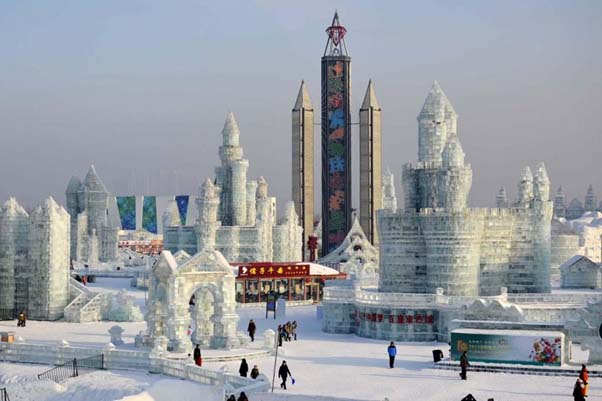Rising Sea Levels and the Threat Posed to South and Southeast Asia
Posted on : April 20, 2024Author : Debendra Sanyal

In 2019, Joko Widodo, the President of Indonesia, announced that the capital city of Indonesia would be shifted from Jakarta to a site in the East Kalimantan province. Three years later, following pandemic-induced delays, site inspections and legislative formalities, it was announced that the new capital will be named Nusantara. On 17 August 2024, on the anniversary of the country’s independence, Nusantara will officially replace Jakarta as the national capital of Indonesia. The move to shift the national capital was influenced by many factors, primary among them being that Jakarta was sinking at an alarming rate, with parts of the city having sunk by more than 4 m since the 1970s.(Doman et al., 2019)
This is a malaise which affects not just Jakarta, but also numerous cities, provinces, islands and countriesaround the world. The dangers posed by global warming and climate change are well-documented and need no further emphasis. In this paper, we will focus on a specific outcome emerging out of climate change, that is, rising sea levels, and how this poses a grave threat to countries, with the region of South and Southeast Asia serving as the case study for the paper.

Rising sea levels of Jakarta
Global warming and rising sea levels
Global temperatures have been on the upswing for the past few centuries, owing to increased accumulation of greenhouse gases in the atmosphere, which is a result of increased industrialisation, over-reliance on fossil fuels for energy needs, and man-made factors like deforestation reducing the green cover which act as heat absorbers. The world’s oceans comprise around 70% of the earth’s area, and the heat from the atmosphere gets transferred to the oceans. As heat storage increases, the oceanic temperatures increase, which lead to thermal expansion of sea water, and thereby, rise in the levels of sea water. According to a study published in January 2023 in the Advances in Atmospheric Sciences, ocean temperatures have reached their highest-ever level in 2022 and are expected to continue rising, with the five hottest years for oceans being in the past six years.(Bhandari, 2023)
Additionally, rising atmospheric temperatures also lead to the melting of large glaciers and ice caps, which contribute massively towards increase in sea levels. The water content stored in glaciers is considered to be equivalent to 0.5 m of global mean sea level rise.(Mimura, 2013) Also, ice sheets, such as those found in Greenland and Antarctica, contain ice equivalent to about 7 m and 3–5 m sea-level rise, respectively. (Mimura, 2013)Cumulatively, all these factors have resulted in alarming levels of rise in sea water. According to United Nations estimates, by 2100, there would be a projected increase of 2.5 degrees Celsius in the global average temperatures, and an increase between the range of 18-59 cm in global mean sea level, as per the fourth Assessment Report of the Intergovernmental Panel on Climate Change. (Mimura, 2013)

Melting ice glaciers of Greenland
Impact on South and Southeast Asia
Rising sea levels pose grave risks to many cities and countries in South and Southeast Asia. These regions possess some of the longest coastlines in the world, and also, happen to be among the largest carbon emitters, thereby contributing massively to global warming, and consequently, towards the rise in sea levels. The region is home to bustling coastal megacities like Mumbai, Chennai, Singapore, Jakarta, Manila, etc., and low-lying countries and island-states like Bangladesh, Maldives, Indonesia, Philippines, etc. According to a 2021 ASEAN State of Climate Change report, with an estimated 77% of the population living in coastal areas, Southeast Asia is one of the world’s most vulnerable regions.(Bhandari, 2023)With continued rising sea levels, the threat and frequency of urban flooding in coastal cities and low-lying areas will greatly magnify. According to a report published in the Nature Climate Change journal, several Southeast Asian megacities would become hotspots of high sea-level rise. For example, in Manila, coastal flooding events within the next century will occur 18 times more often than before, solely because of climate change. But factoring in naturally-occurring fluctuations in sea level increases the frequency of coastal flooding up to 96 times more often than before, the study found.(Subramaniam, 2023) Then there are low-lying countries and island states like Maldives, whose highest points barely exceed 2 m above the sea level, and face the risk of being completely inundated. Some other megacities in the region which face the threat of being partially or completely inundated by the end of the century include Chennai, Bangkok, Jakarta, and Ho Chi Minh City. Moreover, climate change also increases the frequency of natural disasters like floods and typhoons, which would lead to further coastal erosion and depletion of natural barriers such as mangroves. The triple whammy of depleting barriers, rising sea levels and natural disasters would make coastal cities and infrastructures extremely vulnerable. A case in point is the Sunderbans of India and Bangladesh, which suffered immense damage during Cyclone Amphan in 2020, and has borne the brunt of a few more cyclones since then. Rising sea levels have also led to substantial depletion of the mangrove forests. The Sunderbans act as a natural defensive shield against extreme weather events like cyclones, and its depletion would lead to increased vulnerability for vast areas of Bangladesh and the Indian city of Kolkata.

Cyclone Mocha approaching Bangladesh
The existential threat aside, there are socio-economic dangers also associated with rising sea levels. For example, in Bangladesh, more than 100 million hectares of arable land is vulnerable to saline water intrusion, which would adversely impact drinking water supply, agriculture, and aquaculture.(Shrestha et al.,2013) The coastal regions serve important economic functions, such as tourism, trade, and fisheries, and many coastal cities serve as economic hubs of their countries, like Mumbai and Jakarta.This economic dimension amplifies the threat of rising sea levels. Governments would have to allocate significant chunks of their national budget towards combating the effects of global warmingand adaptation measures. “By 2100, the mean cost of climate change for Indonesia, the Philippines, Thailand, and Vietnam could be equivalent to losing 6.7% of combined GDP each year, more than twice the global average loss.”(Asian Development Bank, 2009) Also, with cities and island states facing the threat of inundation, governments would be left with no alternative but to relocate entire populations elsewhere, which would put a huge burden on the receiver regions/states. If such migration remains domestic or internal, “it will come with significant costs and it could lead to internal political instability if not handled effectively.” (Ahluwalia, 2023) However, in a scenario where cross-border migration takes place, regional security problems could potentially arise, as maritime boundaries could collapse and states would get flooded with an influx of refugees, putting a massive strain on the host country’s resources.
According to Verónica Nataniel MacamoDlhovo, Minister for Foreign Affairs and Cooperation of Mozambique, “The international community must consider how to reaffirm the self-determination principle and the continuation of statehood after loss of territory.”(United Nations, 2023)
Furthermore, there are legal and geopolitical implications associated with rising sea levels, such as the demarcation of maritime boundaries and Exclusive Economic Zones. The coastlines of countries serve as baselines, from which the maritime boundary of a state is determined. According to the 1982 United Nations Convention on the Law of the Sea, maritime jurisdictions of a state are of the following categories: territorial waters (12 nautical miles), contiguous zones (24 nautical miles), and Exclusive Economic Zones (200 nautical miles). However, rising sea levelslead to coastal erosion,which would affect the baseline, and thereby a state’s extent of its maritime jurisdiction. “The problem of moving coasts and baselines conflict with the fixity of geopolitical borders, and 1 metre of vertical change can make a disproportionately large difference in terms of sovereignty, territory and access to resources.”(Sammler, 2020) Any changes in the state’s maritime boundaries would affect its access to marine resources like fisheries and underwater minerals, which could have adverse economic impact on the state.“As coasts are pushed landward, affecting baselines and the maritime zones that are measured from the baselines, there will be increased competition over natural resources, forced migration and displacement of populations.” (UN, 2023)In Southeast Asia, states like Philippines, Vietnam, and Indonesia have territorial disputes with China over the issue of maritime jurisdiction claims in the South China Sea. With many of the Southeast Asian states suffering from coastal erosion, this would impact their maritime jurisdiction in the South China Sea, which would have massive implications for them in terms of access to marine resources.
On a broader level, rising sea levels also raise questions about some fundamental assumptions in geopolitical thinking, such as stable physical environment and natural boundaries. “We are likely headed into an era in which new questions of responsibility, liability and justice will be raised – questions that will blur traditional foreign/domestic policy distinctions resulting from new or dynamic geopolitical instabilities.” (Hommel & Murphy, 2013)
Conclusion
In conclusion, rising global temperatures have led to an increase in sea levels over the years, which now pose grave risks to the regions of South and Southeast Asia. For low-lying countries and island states like Bangladesh and Maldives, they face a threat to their very survival. Existential threats aside, there are social, economic, and political challenges as well, such as infrastructural damage, loss of arable land, impact on fisheries and tourism, mass displacement, economic costs of adaptation to climate change, and a lot more. There are serious implications for international law as well, pertaining to statehood, territorial jurisdictions and access to resources. All in all, rising sea levels pose a multidimensional threat,and the countries of South and Southeast Asia need to come together in order to stave off the impending crisis.
References
- Ahluwalia, M.S. (2023, January 7). Climate change challenges Asia Pacific security.East Asia Forum. https://eastasiaforum.org/2023/01/07/climate-change-challenges-asia-pacific-security/#:~:text=Rising%20sea%20levels%20could%20see,is%20in%20a%20similar%20situation
- Asian Development Bank. (2009). The Economics of Climate Change in Southeast Asia: A Regional Review. https://www.adb.org/sites/default/files/publication/29657/economics-climate-change-se-asia.pdf
- Bhandari, S. R. (2023, March 9). Asian cities at increased exposure to rising sea levels, study says. Radio Free Asia. https://www.rfa.org/english/news/environment/sea-level-rise-03092023053115.html
- Doman, M., Lipson, D., & Wu, A. (2019, June 24). Sinking towards disaster. ABC News.https://www.abc.net.au/news/2019-06-24/jakarta-is-running-out-of-time-to-stop-itself-sinking/11190928
- Hommel, D., & Murphy, A. B. (2013). Rethinking geopolitics in an era of climate change. GeoJournal, 78(3), 507-524.https://doi.org/10.1007/s10708-012-9448-8
- Mimura, N. (2013). Sea-level rise caused by climate change and its implications for society. Proceedings of the Japan Academy. Series B, Physical and biological sciences, 89(7), 281-301. https://www.jstage.jst.go.jp/article/pjab/89/7/89_PJA8907B-01/_pdf/-char/en
- Sammler, K. G. (2020). The rising politics of sea level: demarcating territory in a vertically relative world. Territory, Politics, Governance, 8(5), 604-620. https://doi.org/10.1080/21622671.2019.1632219
- Shrestha, M., Ahmed, M., Suphachalasai, S., &Lasco, R. (2013).Economics of Reducing Greenhouse Gas Emissions in South Asia: Options and Costs. Asian Development Bank. https://www.adb.org/sites/default/files/publication/30186/economics-reducing-ghg-emissions-south-asia.pdf
- Subramaniam, T. (2023, March 8). Threat of rising seas to Asian megacities could be way worse than we thought, study warns. CNN. https://edition.cnn.com/2023/03/07/asia/rising-sea-levels-asia-cities-threat-climate-intl-hnk-scn/index.html
- United Nations. (2023, February 14). Climate Change-induced Sea-Level Rise Direct Threat to Millions around World, Secretary-General Tells Security Council. https://press.un.org/en/2023/sc15199.doc.htm
Debendra Sanyal
Intern, Asia in Global Affairs
The views, thoughts, and opinions expressed in the text belong solely to the author, in his personal capacity. It does not reflect the policies and perspectives of Asia in Global Affairs.



